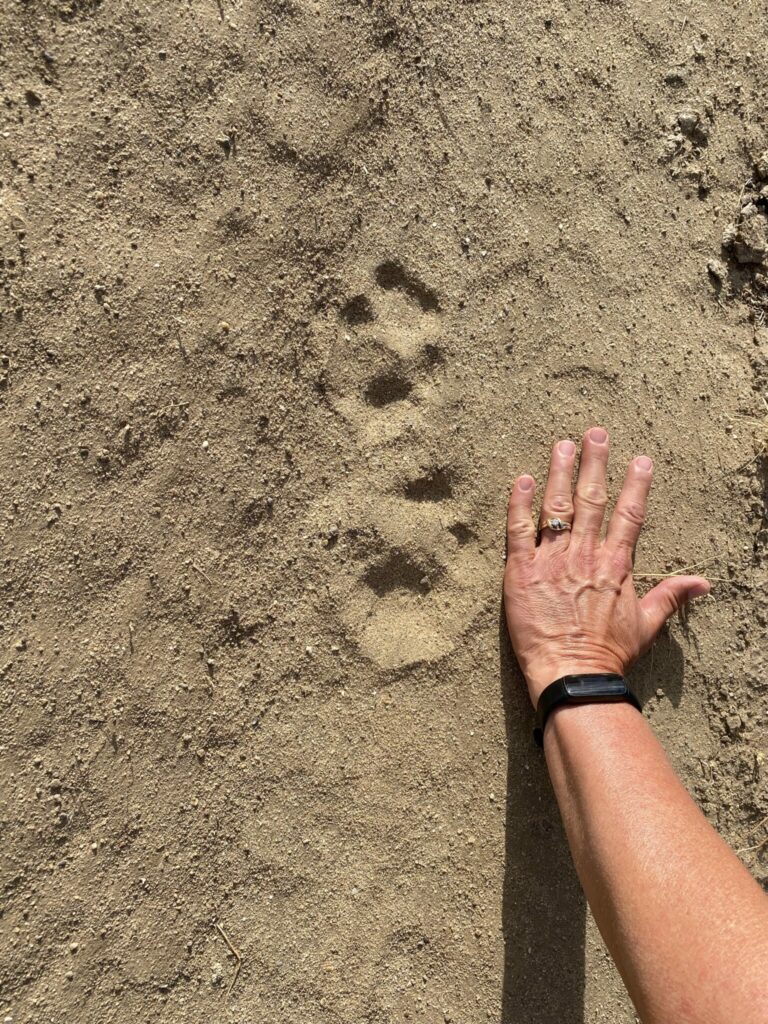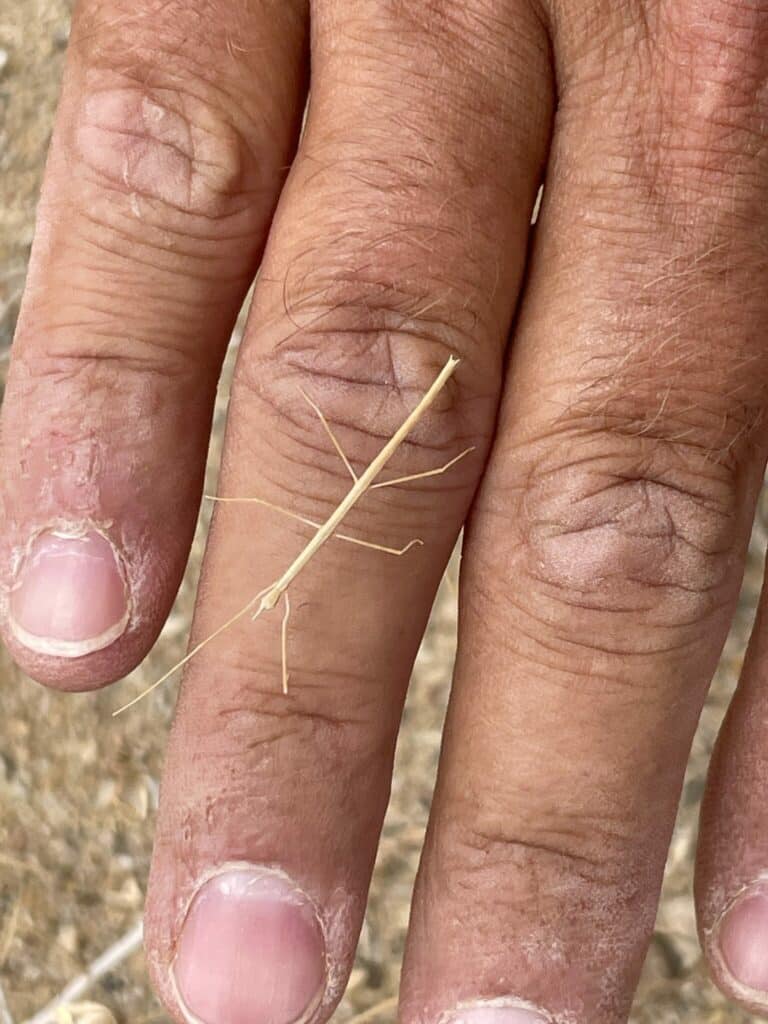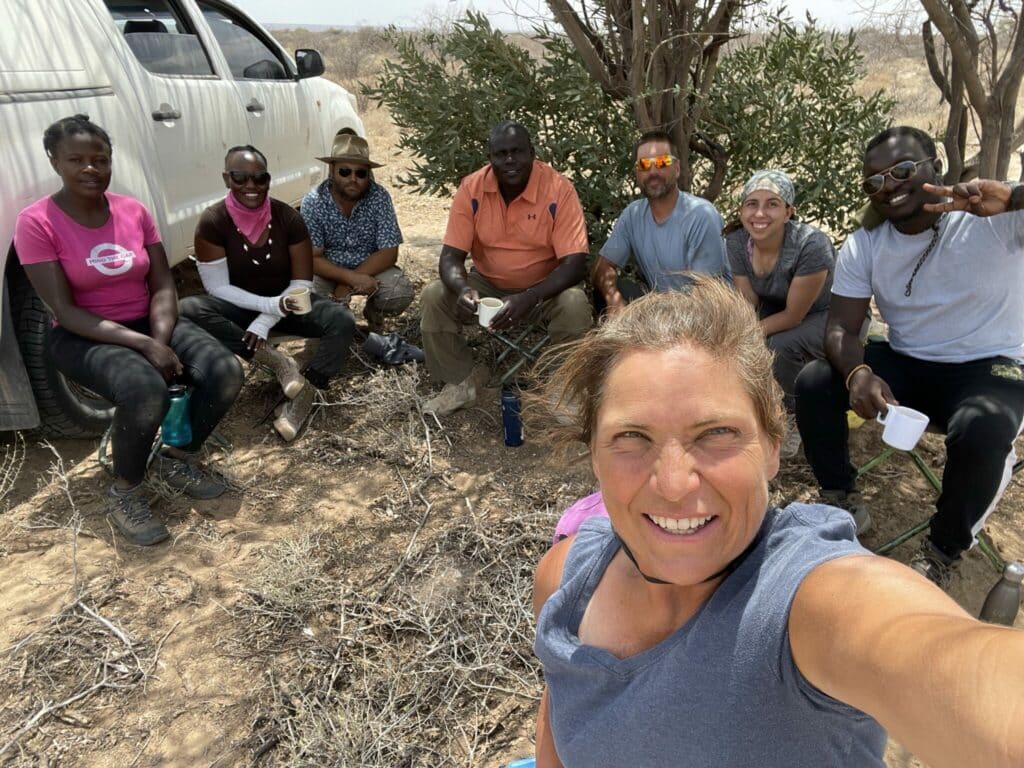Few pictures uploaded due to weak signal at base camp. I can update images once in Nanyuki the last two days of this trip. Enjoy the text for now.
July 15, 2022. Site 102 Boma that has been repeatedly used. We are mapping the Boma as usual with center of Boma and 25 meter plots with transects and 50, 100, 150 meter transects with 7meter plots at each interval. The wind is blowing hard today and Boma is located very near a Laga. Side note: we stopped on drive here to look at VERY fresh lion tracks.

We had a lecture or informative talk, from one of the head wildlife wardens here in Sibiloi National park. It was created by parliament along with other nations parks across Kenya. The primary goal of the park is to promote wildlife (plant & animal) conservation within the park. Poachers have been a problem in the past as most large fauna have been extirpated from the park or are very rare. This area of Kenya is very sparsely vegetated during the dry seasons but greens up a lot during the wet seasons. Climate change is the number one cause for major changes in lake levels, heat increase and vegetation changes. Animals have also been changing too such as flamingos have now been breeding at the park, specifically the Koobi Fora Base Camp area. Pictures of the adults and very young ones will be uploaded soon.
We found a wooden camel bell carved by the Daasanach along with other animal remains indicating what the Daasanach had been eating prior to abandoning the Boma before the dry season hit. While taking vegetation data I found a small walking stick insect. Pictures to follow when reception is better.


July 16, 2022. Today will be doing Boma vegetation work on site 117. I created a couple checklists for supplies to bring into the field and a re-supply list as well. Hopefully this will be useful for next 1.5 weeks we will be collecting data. Update: the supply list was very successful and helped us get everything we needed. We had a group of 11 people and two vehicles today. We drove to the Karari (2 hour one way) and completed a single Boma in record time due to our teamwork and efficiency. This was located in site 117 and the day as cool and cloudy until we were all set up. After that us was sunny, little breeze and hot. On a side note during our last vegetation plot far outside the Boma s a control data plot, Rahab found an old ding beetle dung ball. It was very dried and hardened as a rock, but perfectly round. Without hesitation Rahab picked it up and not it to one of the team members. A game of hitting hitting the ball into the air back and forth (bare hands) with most everyone began. Lots of laughs ensued while a few others calibrated the electronics for data collection. I was able to film the game before everyone was needed to begin collecting data.
July 17, 2022. Today Chelle and I worked on our presentation and completed about 95% of it. We also worked on more lesson plans since the sheer volume of work to be done is staggering. We could easily use and entire week to complete all that we have outlined. One of the challenges to this is that we are continuing to work on Boma vegetation surveys and auditing other projects too when time works out. We took a 30 minute break and walked along the beach a bit and I collected some reeds to build a duck decoy….simply because I could. It looks cool.
More work after the break and lunch. Then laundry time. Washing clothing in a basin by hand is the norm here. We can never use the lake alone or but we can be with large group so long as an armed wildlife ranger accompanies is. The crocodiles are returning to the area (at least the giant ones that laid eggs about April and May) to await their soon to hatch eggs. We have recently seen 10-15 foot long crocodiles swimming just off shore. They are massive and quite intimidating. However we still swim so long g as we have the armed lookout with us. I will say that not all of us go into the water anymore after seeing a crocodile large enough to bite us in half.
July 18, 2022. Site 117 again. Breezy, slightly cloudy in the morning and we are headed to the Karari again. Minimum 4 hours on the road (2 one way) and vegetative counts, drone flying and soil sampling. We finished the Boma in record time having finally fine tuned all aspects of the data collection methods. I understand that it has taken a couple weeks (non consecutive Boma work days) to fine tune the efficiency of the data collection however it was due to the multiple moving parts and equipment. First off we had the list of the following items to bring: robel, TDK system (X2), poles to mount the TDK system, herbaceous vegetation and woody vegetation forms, clipboards, drones & cables, soil collection kit, large shovel, quadrant poles, 4 meter tapes (2 for woody vegetation measuring and 2 for transect lines), Jerry can of water, two separate bags with drone ground points and a few more items. Once at site there are many separate things to do.
For example we have to map out the outside of the Boma to get its area, then find center and create a 25×25 meter plot in center for herbaceous and woody vegetation counts. We then have two transect lines outside of the Boma perpendicular to each other at 150 meters in length. I have described this before yet each time we work on collecting the data we find new ways to improve the system, making it more efficient. Having a crew of 10 workers is helpful as we now have defined roles. First thing to happen is the center point of the Boma is located, marked then the 25 meter plot is marked. Three researchers begin the transect herbaceous data collection while one two person team maps the perimeter. Three of us begin mapping the two different transect lines yet pause at the 50,100,150 meter mark to creat a 7×7 meter plot for herbaceous transects. We also place our quadrant markets and locate the nearest woody vegetation (tree or shrub over 1 meter tall) to the center point of our 50,100,150 mark. When we locate the nearest woody veg, we mark only one in each quadrant with a brightly colored flag, then move to the next one. Once we finish the lines we get the form, robel, and small meter tape and go back to each meter mark to record the physical distance between the center of the 7×7 plot and the flagged woody veg. We also have to record the height, and diameter of the tree/shrub. This is a three person team as one person has the surface computer that connects to the TDK system, another holds the TDK on a pole and at level as close to the trunk as possible, while the third person records the species, height, diameter etc. We then walk to the next meter plot and repeat. We also count and measure ALL woody vegetation over 1 meter high on the 25×25 plot. This allows for comparison between the vegetative changes inside the occupied Boma and the areas surrounding the boma. We should see more woody veg outside Boma compared to inside due to Daasanach clearing inside the Boma area. However during the times the Boma is abandoned, vegetation does come back, but at what rate? Hopefully this explanation has helped explain the data collection and one of the research projects here at Koobi Fora.

July 19, 2022. Again breezy and party cloudy. Going to site 131 in Karari. Geology and bone survey today. We hiked, validated the Burgi Formation for the fossil survey, then surveyed. We didn’t find much in terms of fossils that we actually wanted and when we found some fossils they were too weathered to collect or mark. The area we walked around was very hilly or very level with serious washouts. All together we hiked just over 10 kilometers up and down over large rocks, small cobble stone, sand/silt and powdery tuff. Today was a long day with just the four of us surveying. We did however find some very neat rocks, one of which I have a picture to upload at some point. Other that that, I am tired and finished for the day.
July 20, 2022. Work day today with Chelle. We began very early and got about 7 hours of solid work done. We took a break to walk the beach and look for crocodile nests and hatched eggs. We found over 10 nests, all of which had hatched. After we finished for the day (except we plan to work more in the evening when cooler temps allow for better concentration) I began writing more prose or at least ramblings of thought. I’ll include them on a separate post. I think I’ll close this post early and hopefully get it published. The next post might be a bit shorter with days since we have papers due (lesson plans for Chelle and I), field notebook checkin, final exam, and research project presentations.

